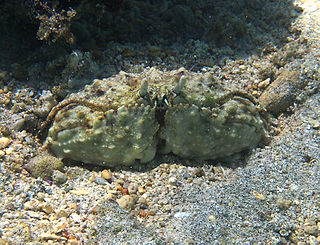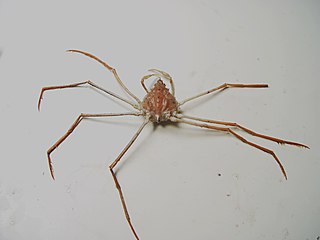
Xanthidae is a family of crabs known as gorilla crabs, mud crabs, pebble crabs or rubble crabs. Xanthid crabs are often brightly coloured and are highly poisonous, containing toxins which are not destroyed by cooking and for which no antidote is known. The toxins are similar to the tetrodotoxin and saxitoxin produced by puffer fish, and may be produced by bacteria in the genus Vibrio living in symbiosis with the crabs, mostly V. alginolyticus and V. parahaemolyticus.

Libinia is a genus of crabs in the family Epialtidae, containing twelve extant species:

Calappa is a genus of crabs known commonly as box crabs or shame-faced crabs. The name box crab comes from their distinctly bulky carapace, and the name shame-faced is from anthropomorphising the way the crab's chelae (claws) fold up and cover its face, as if it were hiding its face in shame.

Majidae is a family of crabs, comprising around 200 marine species inside 52 genera, with a carapace that is longer than it is broad, and which forms a point at the front. The legs can be very long in some species, leading to the name "spider crab". The exoskeleton is covered with bristles to which the crab attaches algae and other items to act as camouflage.

Parthenopidae is a family of crabs, placed in its own superfamily, Parthenopoidea. It comprises nearly 40 genera, divided into two subfamilies, with three genera incertae sedis:

Potamonautes is a genus of African freshwater crabs in the family Potamonautidae. It is both the most widespread and most diverse genus of African freshwater crabs, including more than half the species of this continent. They are found in most freshwater habitats of the African mainland and some species are semi-terrestrial.

Calappidae is a family of crabs containing 16 genera, of which 7 are only known as fossils:

Pilumnoidea is a superfamily of crabs, whose members were previously included in the Xanthoidea. The three families are unified by the free articulation of all the segments of the male crab's abdomen and by the form of the gonopods. The earliest fossils assigned to this group are of Eocene age.

Actumnus is a genus of crabs in the family Pilumnidae. Alongside the 28 extant species, it has a fossil record extending back into the Miocene.

Inachidae is a family of crabs, containing 39 genera:

Macropodia is a genus of crabs, belonging to the family Inachidae. It contains the following species:

Epialtinae is a subfamily of crabs, containing the following genera:

Panopeus is a genus of crabs, containing these extant species:
Osachila is a genus of crabs in the family Aethridae, containing three fossil species, and the following extant species:

Leucosiidae is a family of crabs containing three subfamilies and a number of genera incertae sedis:

Lachnopodus is a genus of crabs in the family Xanthidae, containing the following species:

Paraxanthias is a genus of crabs in the family Xanthidae, containing one exclusively fossil species and the following extant species:

Cyclograpsus is a genus of crabs, containing the following species:

The Panopeidae are a family containing 26 genera of morphologically similar crabs, often known as "mud crabs". Their centers of diversity are the Atlantic Ocean and eastern Pacific Ocean.

Inachoididae is a family of crabs originally erected by James Dwight Dana in 1852. It was not recognised as a valid family until the early 1980s. Its members closely resemble those of the family Inachidae, and the Inachoididae could be recognised as a subfamily of that family.



















